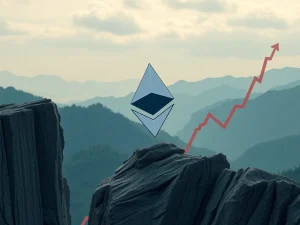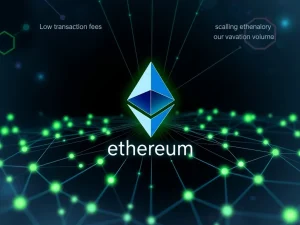Ethereum’s Unyielding Crypto Dominance: Securing 65% DeFi TVL and Billions in Stablecoins

In the fast-evolving world of decentralized finance (DeFi), one blockchain consistently stands out: Ethereum. Despite fierce competition and significant market surges, Ethereum continues to demonstrate unparalleled leadership. If you’re invested in cryptocurrencies or simply curious about the backbone of the digital economy, understanding Ethereum’s enduring crypto dominance is crucial. This article delves into the latest figures, showcasing why Ethereum remains the undisputed king of DeFi, stablecoins, and the burgeoning world of tokenized assets.
Ethereum DeFi TVL: Why Does It Remain Unchallenged?
Ethereum’s hold on the decentralized finance ecosystem is not just strong; it’s foundational. The network, along with its robust layer-2 solutions, commands over $87 billion in Total Value Locked (TVL), which translates to more than 65% of the entire DeFi market. This figure is particularly impressive when considering the global DeFi TVL has surged by a staggering 3.6 times since October 2023. This resilience underscores Ethereum’s unique ability to maintain its lead amidst a rapidly expanding and competitive landscape.
Beyond just TVL, Ethereum’s infrastructure secures an astounding $1.08 trillion in value across 56 of the top 100 tokens by market capitalization. To put this into perspective, this is nearly 2.6 times the $404 billion secured by Solana across its 20 tokens. This data firmly establishes Ethereum as the most trusted and secure infrastructure for digital assets, a reputation built on its extensive operational history and a security framework that has proven itself time and again.
The Power of Ethereum Stablecoins: Fueling the Digital Economy
Ethereum’s influence extends profoundly into the stablecoin market, where it reigns supreme. Over $147 billion in stablecoins are hosted on the Ethereum network, representing more than 60% of the total stablecoin supply across all blockchains. This massive sum includes $74 billion in USDT alone, a figure that astonishingly surpasses the combined TVL of many of Ethereum’s own DeFi protocols.
Stablecoins are the lifeblood of DeFi, acting as a crucial bridge that enables seamless lending, borrowing, and trading while mitigating the inherent volatility of cryptocurrencies. Ethereum’s leadership in this domain solidifies its role as the primary settlement layer for stablecoin activity. This function is critical for maintaining liquidity and ensuring price stability within decentralized markets, making Ethereum indispensable to the broader crypto economy.
Beyond Crypto: Tokenized Assets Find Their Home on Ethereum
Ethereum’s ascendancy in the realm of tokenized real-world assets (RWAs) further cements its position as the go-to platform for bridging traditional finance with the digital world. The network currently hosts $7.7 billion in RWAs, accounting for an impressive 90% of all on-chain tokenized assets. This segment has witnessed explosive growth, increasing tenfold since January 2022, largely driven by increasing institutional adoption for tokenizing treasuries, credit instruments, and various funds.
The ability to securely tokenize high-value traditional assets demands a blockchain network with unparalleled security, decentralization, and reliability. Ethereum delivers these qualities through its vast network of over 1 million validators and its architecture, which is designed to avoid single points of failure. This robust foundation is why major institutions increasingly choose Ethereum for their tokenization initiatives, seeing it as a secure and compliant pathway to digital asset innovation.
What Underpins Ethereum’s Crypto Dominance?
Ethereum’s sustained leadership is not a matter of luck but a direct result of its strategic advantages and continuous innovation. While newer competitors like Solana and Binance Smart Chain offer faster transaction speeds and lower fees, Ethereum’s foundational security model and expansive developer ecosystem remain unmatched. The introduction and widespread adoption of Layer-2 scaling solutions have allowed Ethereum to enhance its scalability significantly without compromising its core principles of decentralization and security. This delicate balance has successfully attracted both institutional and retail capital, leading to billions in assets being secured through its smart contracts and Layer-2 networks.
Navigating the Future: Sustaining Ethereum’s Dominance
The implications of Ethereum’s enduring leadership extend far beyond mere market share statistics. Its capacity to secure such an immense volume of value is a testament to the profound trust users place in its infrastructure. This trust, in turn, fosters deep liquidity, which then acts as a powerful magnet, attracting more developers and innovative applications. This creates a self-reinforcing flywheel effect that further strengthens the network’s position.
As the decentralized finance landscape continues to evolve, Ethereum’s role as the fundamental backbone of this new financial system is only likely to strengthen. With ongoing advancements like Ethereum 2.0 (now known as the Merge and subsequent upgrades) continually improving its scalability and efficiency, combined with its increasing integration of real-world assets, Ethereum is poised to maintain its pivotal role at the forefront of the digital economy.
Disclaimer: The news articles available on this platform are generated in whole or in part by artificial intelligence and may not have been reviewed or fact checked by human editors. While we make reasonable efforts to ensure the quality and accuracy of the content, we make no representations or warranties, express or implied, as to the truthfulness, reliability, completeness, or timeliness of any information provided. It is your sole responsibility to independently verify any facts, statements, or claims prior to acting upon them. Ainvest Fintech Inc expressly disclaims all liability for any loss, damage, or harm arising from the use of or reliance on AI-generated content, including but not limited to direct, indirect, incidental, or consequential damages.
Frequently Asked Questions (FAQs)
Q1: What does ‘DeFi TVL’ mean and why is Ethereum’s share significant?
DeFi TVL stands for ‘Total Value Locked’ in decentralized finance protocols. It represents the total value of all crypto assets deposited into DeFi applications. Ethereum’s 65% share is significant because it indicates that the vast majority of capital and activity in the DeFi space occurs on the Ethereum network or its Layer-2 solutions, highlighting its primary role and user trust.
Q2: How do Ethereum Stablecoins contribute to its dominance?
Ethereum hosts over 60% of the total stablecoin supply across all blockchains, including major stablecoins like USDT. Stablecoins are crucial for facilitating lending, borrowing, and trading in DeFi by providing price stability. Ethereum’s dominance in stablecoin issuance makes it the primary settlement layer for these critical assets, reinforcing its position as the core infrastructure for the digital economy.
Q3: What are Tokenized Assets (RWAs) and why are they important for Ethereum?
Tokenized Assets, or Real-World Assets (RWAs), are representations of tangible or intangible assets (like real estate, bonds, or commodities) on a blockchain. Ethereum hosts 90% of all on-chain tokenized assets, attracting institutional adoption due to its robust security and decentralization. This trend is crucial as it bridges traditional finance with the blockchain world, expanding Ethereum’s utility beyond native cryptocurrencies.
Q4: What gives Ethereum its Crypto Dominance despite newer competitors?
Ethereum’s crypto dominance stems from several factors: its first-mover advantage, unparalleled security validated over years, a vast and active developer ecosystem, and the successful implementation of Layer-2 scaling solutions. While competitors offer faster transactions or lower fees, Ethereum’s balance of decentralization, security, and scalability through Layer-2s has maintained its status as the most trusted and adopted network.
Q5: What are Layer-2 solutions and how do they help Ethereum?
Layer-2 solutions are scaling technologies built on top of the Ethereum blockchain designed to process transactions off the main chain (Layer-1) to reduce congestion and lower fees. Examples include Optimism, Arbitrum, and zkSync. They help Ethereum maintain its scalability and efficiency, allowing it to handle more users and transactions without compromising its core security and decentralization, thereby supporting its continued growth in DeFi and other areas.










